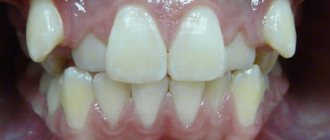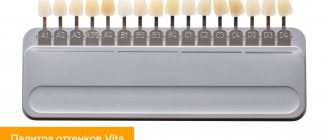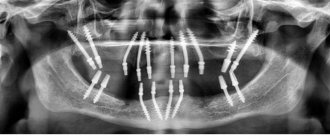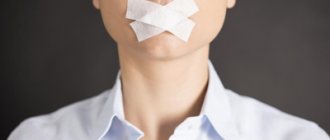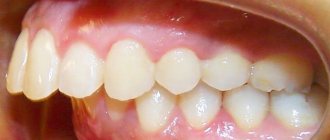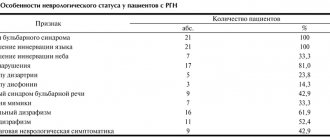A small chin (medically called inferior micrognathia, or microgenia) is an incredibly common problem.
However, most people who can be confidently diagnosed with this have not only not heard such words, but also do not suspect that there is anything wrong with them. They are healthy, everything is in place. But no matter how hard they try to achieve an ideal appearance, it doesn’t work!
Neither losing weight, nor taking care of your face, nor changing your hairstyle helps. It's not clear what's going on! As a result, people either come to terms with the fact that everyone is imperfect, or they suffer all their lives because the ideal is unattainable for them personally.
What is microgenia (micrognathia) of the lower jaw
Microgenia of the lower jaw is nothing more than a small underdeveloped chin. A defect in appearance caused by a lack of bone in the chin area.
A young girl contacted Platiennetal with complaints about a small chin and asymmetry of the chin area.
A chin augmentation was performed using a Porex implant, Bisha's fat bags in the cheek area were partially removed. It was possible to visually narrow and “stretch” the oval of the face, making it harmonious.
Performed by: plastic surgeon Andrey Iskornev
Photo from the patient’s personal archive. Surgeon: Iskornev A.A.
Performed: upper blepharoplasty, ️installation of a chin implant, medial and lateral platysmaplasty with neck lift through an incision in the earlobe. Performed by a surgeon - Maxim Vasiliev .
A small or sloping chin spoils any face. And if a small chin in men can still be hidden under a thick beard (for those who find the strength to wear this “decoration”, which makes the owner look ten years older), then a small chin in women cannot be disguised.
Looking at a human face, we often see only the whole and do not notice the details.
A short chin in itself is not noticeable and is not perceived as a flaw. But with its size it violates the proportions. From the side, a fuzzy oval of the face, early wrinkles, folds on the neck and a premature double chin are visible. And only a specialist - a maxillofacial surgeon or an orthodontist - will understand that the reason is the insufficient size of the chin.
Malocclusion in a child: identify and correct it in time!
Normal or pathological bite?
If the teeth in the lateral section close so that each upper tooth falls between the two lower ones (this position of the teeth is also compared to a caterpillar tractor), and the upper front teeth overlap the lower ones by one third, then such a bite can be called normal, even standard.
And doctors call it orthognathic. Variants of the norm also include the correct closure of the lateral surfaces, but at the same time a slight rotation or rotation of one of the teeth, as well as small gaps (diastemas) between the teeth. Also within normal limits, there may be slight crowding of the teeth in the lower jaw.
Now let's talk about bite pathologies... These include distal bite, when the upper jaw is strongly pushed forward relative to the lower jaw. Such a bite may be associated with underdevelopment of the lower jaw with a normally developed upper jaw or, conversely, with an overdeveloped upper jaw against the background of normal development of the lower jaw. A similar bite pathology can occur due to congenital (hereditary) underdevelopment of the jaws, as well as due to impaired nasal breathing or due to a number of pathologies of other body systems. For example, due to difficulty in nasal breathing, a child has to breathe through his mouth, as a result of which the cheek muscles are in a tense state, which prevents the development of the lower jaw. Also, the formation of a pathological distal bite is promoted by throwing back the child’s head during sleep. Recession of the lower jaw in this position of the head leads to its underdevelopment. The problem of distal occlusion arises and is identified in childhood, when the formation and growth of the body as a whole occurs.
Mesial bite is most often the result of a skeletal abnormality, that is, a problem in the structure of the lower jaw. This is mainly a hereditary form of malocclusion. Since the lower jaw is overdeveloped, it is pushed forward in relation to the upper. Those with this type of bite are characterized by a large, so-called archaic chin. This malocclusion pathology is most often treated surgically: a resection (removal of part) of the jaw is performed, and only then the position of the teeth is corrected with the help of braces.
Another type of bite pathology is an open bite, when the teeth in the lateral regions close together, but not in the front. This type of bite develops as a result of bad habits - prolonged nipple sucking (up to 4-5, and sometimes 6 years), thumb sucking, and also in children who chew pencils. You may ask, where do bad habits in children come from? Let's figure it out. As we know, breastfeeding is of great importance in the formation of the bite. A child is born with a distal bite, when the lower jaw is slightly behind, and this is the norm for a newborn. It is this position of the jaws that allows the baby to simultaneously swallow milk and breathe. When a baby suckles at the breast, he is forced to make certain muscular efforts and move his jaw forward. This stimulates the growth and development of the lower jaw. If breastfeeding is not available, the baby is bottle-fed. Often, mothers make too large holes in the nipple in order to “facilitate” the sucking process for the baby, and the milk actually pours into the mouth itself - the baby no longer needs to make any effort during the sucking process. The result is that the lower jaw does not develop. When the baby switches to regular food, he compensates for the sucking stage by sucking fingers, pacifiers, etc. The second important factor in the formation of bad habits is difficult nasal breathing, in which the child is forced to constantly keep his mouth open. Try sitting for a long time with your mouth open. Even for an adult whose facial muscles are well developed, this is quite difficult. Trying to alleviate the situation, the child puts a finger or a pencil in his mouth so that the muscles relax. After all, “leaning” on a pencil, he can calmly breathe through his mouth for a long time.
Therefore, parents should understand how important it is to avoid the formation of bad habits: they need to choose orthodontic nipples with the required number and diameter of holes (they can be bought at almost any large pharmacy) and “force” the baby to suck correctly, as well as resolve problems that impede the child’s free nasal breathing depending on the reasons creating these problems. Believe me, the formation of a child’s correct bite largely depends on the mother.
However, if the baby has already become the owner of one or more bad habits, then this can be treated quite successfully: at the age of 5–6 years, the nipples are replaced with special plates with flaps and grilles for the tongue, which allow you to quickly correct an open bite.
In a deep bite, the upper jaw overlaps too much with the lower jaw. The reasons for the development of a deep bite are mainly underdevelopment of the lower jaw, skeletal forms of anomaly, or such a bite can be caused by a certain position of the teeth. This bite is considered traumatic, since when chewing, the lower incisors hit the upper palate. As a result, traumatic gingivitis develops.
Crossbite is another type of pathological bite that occurs mainly in the lateral parts of the jaw. Outwardly, it looks like a shift of the chin to one side or the other. Crossbite can develop as a result of jaw injury, underdevelopment of the lateral parts of the lower jaw, as well as a bad habit - when a child sleeps or sits with his cheek propped up with his fist (at the age of 5–6 years). Moreover, in an adult, such a bad habit has no effect on an already formed bite.
Meeting an orthodontist
It is necessary to visit a pediatric orthodontist for the first time at the age of 3.5–4 years, when preparations are underway for the formation of a permanent bite. At this age, distal and medial bites can be diagnosed. If necessary, treatment will be prescribed: wearing plates or caps. At the same time, you cannot yet determine a deep bite, since it is the norm during this period.
The rudiments of permanent teeth begin to form while the baby is in the womb, and this process continues in the first years of life. The baby teeth are close to each other, but at the age of 3.5 years, as the jaws grow, gaps between the teeth (diastema) begin to appear, and by the age of 6 they can reach the distance of one baby tooth. This is due to the fact that the buds of permanent teeth and the permanent teeth themselves are larger than milk teeth. Therefore, this is a normal process that should not cause any concern to parents.
In addition, parents are often frightened by the “disproportionately” large erupted permanent incisors. However, this is normal, because the jaw will grow, and over time, the once “too large” teeth will become absolutely normal, that is, proportional to the size of the jaws.
If the doctor does not reveal any violations, then the next visit should take place at 6–7 years of age - during the period of replacement of milk teeth with permanent ones. First, the “sixes” erupt (by the way, there are no 6 primary teeth) and the incisors are replaced. At this age, it will be clear whether there is enough space for all the other teeth. If not, then at this stage you should begin orthodontic treatment - wearing mouth guards or plates. The purpose of the plates in this case is to stimulate jaw growth and straighten teeth. Mouth guards are designed to correct the bite, widen the jaw, and eliminate bad habits.
If at the age of 6–7 years no malocclusion was detected, then the next visit to the orthodontist is necessary at 10 years. At this age, the distant – 4th and 5th – chewing teeth, as well as canines, begin to change. And it is the fangs that may not have enough space in the row. This problem can be solved by using plates or partial braces on the front four teeth.
It is also necessary to be observed by an orthodontist during the period of eruption of “eights” (the so-called wisdom teeth) - at about 16-17 years old, but now there is a tendency towards earlier eruption of 8 teeth (at 15 years). They can greatly affect your bite. If there is not enough space for the insidious “eights” to erupt, this can lead to crowding of teeth, often to an even greater extent than before. And then wearing braces cannot be avoided. In cases where wisdom teeth have not erupted, it is necessary to take an x-ray, which will help determine how much their rudiments will affect the bite. If there is not enough space in the jaw and the “eights” begin to put pressure on the 7th teeth, then all four rudiments of the 8th teeth will most likely have to be removed. And such removals have a fairly high percentage - approximately 80 out of 100 cases, especially if the teeth are large.
Bite correction
To correct the bite in childhood, plates and mouth guards are mainly used - that is, removable structures. From 6 to 12 years of age, if necessary, children wear plates that, by putting pressure on the growth zones, stimulate the jaws and allow them to develop correctly. Of course, it is not necessary to wear the plates all the time: for example, after 1–1.5 years of correction, a break is taken (and at the time of changing teeth, they are removed without fail). As the jaws grow, the plates change. And the sooner we begin to correct the bite, the shorter the periods of wearing the plates and the faster the desired result is achieved.
Since the plates are removable structures, it is very important that the child does not forget to put them on. And if the baby does not want or forgets to wear the plates, then the responsibility for following medical recommendations falls on the parents. You need to wear the plates at least 12 hours a day, maximum 16, mostly at night and several hours during the day, and remove them while eating and playing sports. Actually, the longer the child wears the plate during the day, the faster the correction process occurs.
As practice shows, if a child tolerates the plates well, then at a later age he no longer returns to the orthodontist and avoids longer bite correction with the help of braces and the subsequent long-term (and sometimes lifelong) wearing of retainers (retaining arches, caps). , records).
If we are talking about bite correction at 12–14 years old, then braces are used. At this age, the period of wearing braces depends on the pathology of the bite and its severity. However, in adolescents, correction usually occurs faster: it is enough to wear braces for a year (in adults – 1.5–2 years). During the retention (or holding) period at this age, an arch is not placed, as in adults, but removable structures are used - plates or mouthguards (it is easier to maintain hygiene with them), which must be worn at night. On average, after 2 years, the retention period ends (in adults it takes 2 years or more).
Contraindications for orthodontic treatment
Orthodontic treatment for children with mental illness, organic diseases of the central nervous system (for example, with cerebral palsy), oncology and any other serious diseases of any organs and systems of the body is not carried out.
Relative contraindications may include periodontitis and grade 2–3 tooth mobility. And, of course, in pediatric orthodontics we often have to deal with the problem of poor oral hygiene. Moreover, if with children, say, up to 12–13 years old, parents cope and are able to control the timely brushing of their teeth, then with teenagers this situation most often gets out of control. If a teenager does not take care of his hygiene, then wearing, for example, braces leads to the rapid development of caries. In these cases, we advise you to “outgrow” a difficult age - after all, you can start correcting your bite at any time when a person has motivation and responsibility.
Why is a small chin bad?
Try a little experiment. Take a full-face photo of yourself and mentally divide your face into three parts: the upper one - from the hairline to the eyebrow area, the middle one - from the eyebrow area to the tip of the nose, and the bottom one - from the tip of the nose to the base of the chin.
Now arm yourself with a ruler and see if these parts are equal to each other. Equal? Congratulations – your face has the correct proportions. Not equal? What third violates the harmony of features? There is a very high probability that the lower part of the face is to blame for the occurrence of disproportion.
The basic laws of beautiful facial proportions - the “rule of three thirds” - were formulated by Leonardo Da Vinci.
Therefore, in order to improve your appearance as a whole, it is enough to simply “build up” your chin a little. Is it possible? Maybe. At Platinental we do this every day.
Exercises to correct your bite
After identifying malocclusion in children, the doctor may prescribe myogymnastics. The therapy is aimed at restoring muscle motor activity, training the tongue and lips. To correct a child’s bite, it is necessary to achieve myodynamic balance: the strength of the muscles outside and inside the oral cavity must be equal. The development of facial and dental pathologies can provoke weakening of muscle tissue.
A set of therapeutic exercises:
- Massage your lower and upper lips with your index finger for 3-5 minutes. The exercise must be repeated several times a day.
- Connect 2 large buttons with a cord. The child must hold one of them with his teeth, and the second he must pick up and stretch the lace. Do 10 approaches.
- Pull out your lips with a tube. Forcefully inhale and exhale air through your mouth. Repeat the exercise several times.
- Purse your lips tightly and draw air into your mouth. Press your fingers on the swollen cheeks, do 5-7 approaches.
- The lips, stretched out like a tube, should be compressed and unclenched with force. Perform the exercise for 2-3 minutes.
- Move the lower jaw forward as much as possible, and try to reach the upper lip with your teeth. Fix the position for 2-3 minutes.
- Place a plastic ruler between your lips and press on the opposite edge with your finger.
- Hold the plastic card between your lips and hold the position for a few minutes.
Tongue exercises are best done after gymnastics. These include:
- counting teeth from the inside;
- stroking the soft and hard palate with the tongue;
- clicking.
If a child has one or more teeth growing incorrectly, they can be gently pressed with the tip of the tongue from the inside for 2-3 minutes. To strengthen the cheek muscles, the child should take water into his mouth and hold it for several minutes, then spit it out. To practice breathing, experts recommend alternately pinching first the left, then the right nostril.
The technique has age restrictions. Treatment can begin at 3 years of age. Playing the trumpet and other wind instruments and blowing soap bubbles through a plastic tube or straw will help train your muscles.
How to get rid of prognathia?
Since distal occlusion is a complex dental pathology, its correction usually consists of several stages. In some cases, surgical intervention is not possible. However, this is not a prerequisite for the treatment of prognathia - modern dental technologies make it possible to solve the problem without surgery. The easiest way to treat distal occlusion is in children and adolescents, that is, during the period when the development of the dental system has not yet been completed or has just stopped.
Duration of treatment
The duration of correction is largely determined by the age of the patient. However, you must immediately prepare yourself for several months of wearing orthodontic structures. During the period of mixed dentition, children will have to wear special devices for a year and a half. In adults, wearing braces may take several years to obtain lasting results. However, a person quickly gets used to any devices and stops feeling them. And you shouldn’t refuse correction, since prognathia can lead to serious problems in the foreseeable future.
Correction of distal occlusion in adults
It is better to treat prognathism in childhood or adolescence, because later, to correct the distal bite, surgical intervention may be necessary - orthognathic surgery, which is also called genioplasty. It consists of correcting the shape of the chin. This is a rather complex operation, and many orthodontists prefer to mask the pathology by correcting the position of the teeth with braces or special mouth guards. In most cases, several teeth have to be removed. As a rule, these are premolars or molars. Thanks to masking treatment, doctors correct the patient's profile. However, in case of severe pathology, it is unlikely that it will be possible to achieve the desired results in this way.
After treatment for prognathia is completed, orthodontists prescribe wearing a retainer, a bite former, and performing myogymnastics. This is done in order to consolidate the result obtained, since at first the teeth will tend to return to their usual abnormal position.
Diagnosis of mesial occlusion
As can be seen from the above, mesial occlusion has signs. And there are reasons. And these concepts should not be confused. Those. You should not treat the signs (“third class closure” or “protruding lower jaw”). The cause needs to be treated. Before that, of course, it was determined diagnostically.
Diagnosis is the first and key step in the treatment of mesial occlusion. Do you want to know why it is impossible without diagnosis?
In addition, the causes of mesial occlusion, as can be seen from the text above, can be divided into dental and skeletal. And skeletal causes can be divided into jaw and postural (related to posture). And all these reasons can be combined in various ways.
In general, in order to clearly understand the cause of mesial bite, in each specific case, a diagnosis is needed. Only after analyzing the diagnostic data will it become clear how and with what to treat mesial occlusion in this particular patient.
The main types of diagnostic studies for mesial occlusion are:
- analysis of lateral TRG (teleradiogram). It allows you to identify jaw factors (size and position of the jaws) of mesial occlusion
- analysis of jaw models (dentition). It allows you to identify the “dental” causes of mesial occlusion
Analysis of lateral TRG.
Analysis of jaw models.
When does a child need to have their bite corrected?
You can be of any age to correct your bite. Treatment can begin at 3-4 months. You can notice a malocclusion in an infant by abnormal breathing: it is often difficult. During feeding, you need to pay attention to the position of the baby's head: it should not be thrown back or pressed with the chin to the chest.
In children under 2 years of age, the facial muscles are poorly developed, so it is impossible to recognize an incorrect bite without consulting a specialist. In this case, hardware techniques are not used; the child can be prescribed physiotherapeutic procedures and massage.
In children over 5 years of age, disorders are clearly visible. The child's speech may be impaired, as well as chewing function. The defect can be seen upon visual inspection: the teeth grow incorrectly (displaced, crowded). The child has asymmetry of the jaw or face (partial closure, protruded lower or upper jaw).
If the molars grow incorrectly, the child may complain of headaches, constant biting on the inside of the cheeks and clicking in the temples.
Distal bite - what is it?
This is a violation of the closure of teeth, which occurs when the jaws develop incorrectly: the upper jaw is overdeveloped or the lower jaw is underdeveloped. There are also cases that combine the described developmental anomalies, that is, both jaws have pathology. Distal occlusion, or prognathia, as it is also called, is characterized by a significant protrusion of the upper dentition over the lower one. Because of this, the chin often looks small, and the general facial expression at rest can be mistaken for dissatisfaction or surprise.
The extent of prognathia can be understood by the position of the upper first molar, which dentists often call the “six”. The more this tooth comes into contact with its “neighbor” below, the easier the stage. The curvature is considered severe in the case when the upper first molar, when the jaws are closed, is between its lower twin and the second premolar, that is, between the “six” and “five”.
